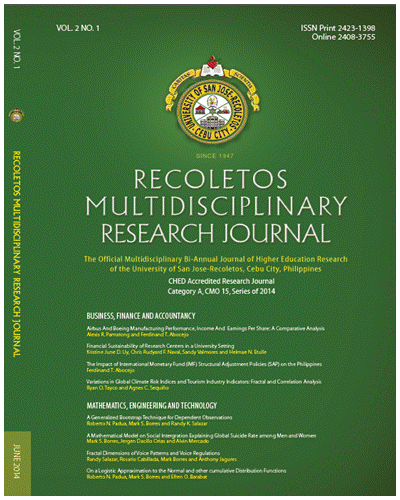A Theory on Multiple Sexual Partnership
DOI:
https://doi.org/10.32871/rmrj1402.01.09Keywords:
multiple sexual partnership, theory, societal modelsAbstract
Human sexual partnership has evolved over time, from single partnerships to
multiple partnerships. The reasons for people engaging these sexual relationship
arrangements vary from person to person. Some studies have already been made about multiple sexual partnership that evokes the biological needs of humans, but the occurrence of MSP due to social modelling has bunked to be unstudied and was not explored thoroughly. This study examines the underlying reasons and practice of multiple sexual partnerships through societal exemplifications, understanding of individuals’ preference towards pleasure not just by man’s innate biological needs. The formulated theory in this study describes, explains and justifies the enumerated
reasons of committing multiple sexual partners outside or within the context of
marriage. With it, this study relinquishes another perspective about the occurrence of multiple sexual partnerships.
References
Baumeister, R. F., and Tice, D.M. (2001). The Social
Dimensions of Sex. Needham Heights, MA: Allyn and Bacon Bem, D. J. (1972). Self Perception Theory. In L. Berkowitz (ed). Advances in Experimental Social Psychology, Vol 6.
Berscheid, E., & Walster, E. (1994). Physical Attractiveness. In L. Berkowitz (ed.). Advances in Experimental Social Psychology. Vol. 7, 1974.
Betzing, M. A., Oeltjen, J. C., Schwartz, S. O., et al. (1998). Comparative Sequence Analysis of a gene-rich cluster at human chromosome 12p13 and its syntenic region in mouse chromosome 6. Genome Res 8: 29-40.
Cassidy, V., Peter, B., & Lee P. (1989). The Body and Society:Men, Women, and Sexual Renunciation in Early Christianity. New York, NY: Columbia University Press.
Chirwa, W.C. & Chizimbi, S. (2009). Multiple and Concurrent Sexual Partnerships in Malawi: A Formative Qualitative Study. Research to
Prevention (R2P). The Summit Consulting Group.
Das, S.K., Esmail, A., and Eargle, L. (2009). Men’s Exploration of Multiple Sexual Partners: Economic vs. Psychosocial Explanation, NI: The Journal on Sex Research.
Freud, S. (1961). The ego and the id. In J. Strachey (Ed. and Trans.) The standard edition of the complete psychological works of Sigmund Freud (Vol. 19, pp. 3 - 66). London: Hogarth Press. (Original work published 1923).
Heider, F. (1958). The Psychology of Interpersonal Relations. New York: John Wiley and Sons, Inc., pp.322.
Kashdan, T. (2009). Curious? Discover the missing ingredient to a fulfilling life. New York, NY: Harper Collins.
Kenrick, M. V. and Keefe, K.J (2003). The Role of Sequential and Concurrent Sexual Realtionships in the Risk of Sexually Transmitted Diseases among Adolescents. J. Adolescence Health. Department of Epidemiology and Biostatistics, Case Western Reserve University.
Cleveland, Ohio, USA. 296-305.
McLeod, J. (2008). A Framework for the Practice of Embedded Counselling: The Aignificance of the Story. In S.Trygged and S. Larsson (eds) Counselling i Socialt Arbete. Stockholm: Gothia Forlag.
Msolamba, V.T. (2009). Parental Investment and the Control of Sexual Selection: Predicting the direction of sexual competition. Proceedings of Royal Society of London. Series B.
Ptak, S.E., Lachmann, M. (2001). On the evolution of polygamy: A theoretical examination of the polygamy threshold model. Standford University. Standford, CA 94305. http://www.santafe.edu/media/workingpapers/01-01-001.pdf
Ricker, J. (2006). Introduction to Scientific Method of Psychology. New York: McGraw-Hill.
Santelli, P. F., Annison, M., et.al (1998). Structure of the human fetal globin gene locus. Nature 278: 227-31.
Sinauer, P.W. (2001). Sexual Behavior and Patterns of Sexual Relationships. New York, NY: Columbia University Press
Walters, R. (1996). Social Learning and Personality Development. New York: Holt, Rinehart & Winston.
Wertsch, J.V. (1985). Cultural, Communication, and Cognition: Vygotskian Perspectives. Cambridge University Press.
Downloads
Published
How to Cite
Issue
Section
License
Copyright of the Journal belongs to the University of San Jose-Recoletos


